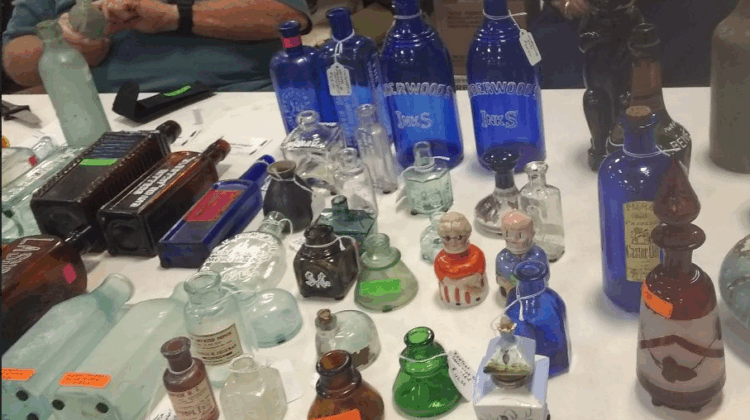
For a long time now we have told marble collectors just how much fun you can have at a bottle show. We have attended them for years and we have never been disappointed nor have we ever failed to find some kind of fascinating marbles. And there are always friendly collectors who offer marbles at fair prices.
This show, like most of those which we have attended lately, advertises that they offer collectibles as well as bottles. For example, they have toys, Native American artifacts, photographs, signs, intriguing Civil War artifacts and much, much more. We are actually exhausted every time when we finish looking.
This Show Was A Tremendous Amount Of Fun
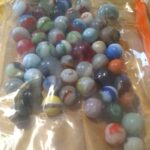
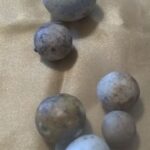
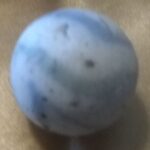
We have not started sorting the plastic bag (above left) but it looks like there are lots of winners. For example, the bright red shooter in the middle of the bag looks Akro Agate and there is a Bumble Bee at the bottom. Isn’t that a 9-swirl bottom right?
We know that many marble collectors don’t care for stone, clay, and so on. We do like them and have added over one hundred mineral marbles to our collection over the years. Perhaps these are not as exciting as glass, but we know that each and every one holds a ton of history, mystery, and secret stories. The stone at the bottom of the center photo looks like a cultured cobble. The Bennington to the top of the cobble is a Fancy one. The newest of the lot may be the small tan Dyke. One or two have Ferris oxide or iron stain.
In the photo to the right is one of our favorite types of clay marbles. We have only ever found one in the wild and that was in Griffin Georgia years ago. Jo found a pristine one. This one was played with and has a ding or two. It is called Variegated Jasper.
A variegated Jasper clay marble is a type of antique toy marble made from clay, and typically dating back to the late 19th to early 20th century. Most are ¾” shooters like this one.
They are made from fired clay. Most are from Germany. The variegated pattern refers to its multicolored or mottled appearance with streaks of different earthy tones like the blue and green in this one. They look like jasper stone and mimic its appearance so that’s why they are called Jaspers. They were hand-formed and fired in kilns which gives each marble a unique pattern.
These marbles are now considered collectible artifacts and are often found in archaeological digs or antique collections. They reflect a time when toys were crafted from natural materials and valued for their artistry as much as their playability[1].
You Found It Where?
For a few years now at bottle shows we have found one or two marbles which the diggers tell us were dug from a privy in New Orleans. This year we found something different: bags of “junk” dug from privies while bottle collectors were hunting for valuable bottles. Previously published in this magazine is a story about “outhouse” marbles.
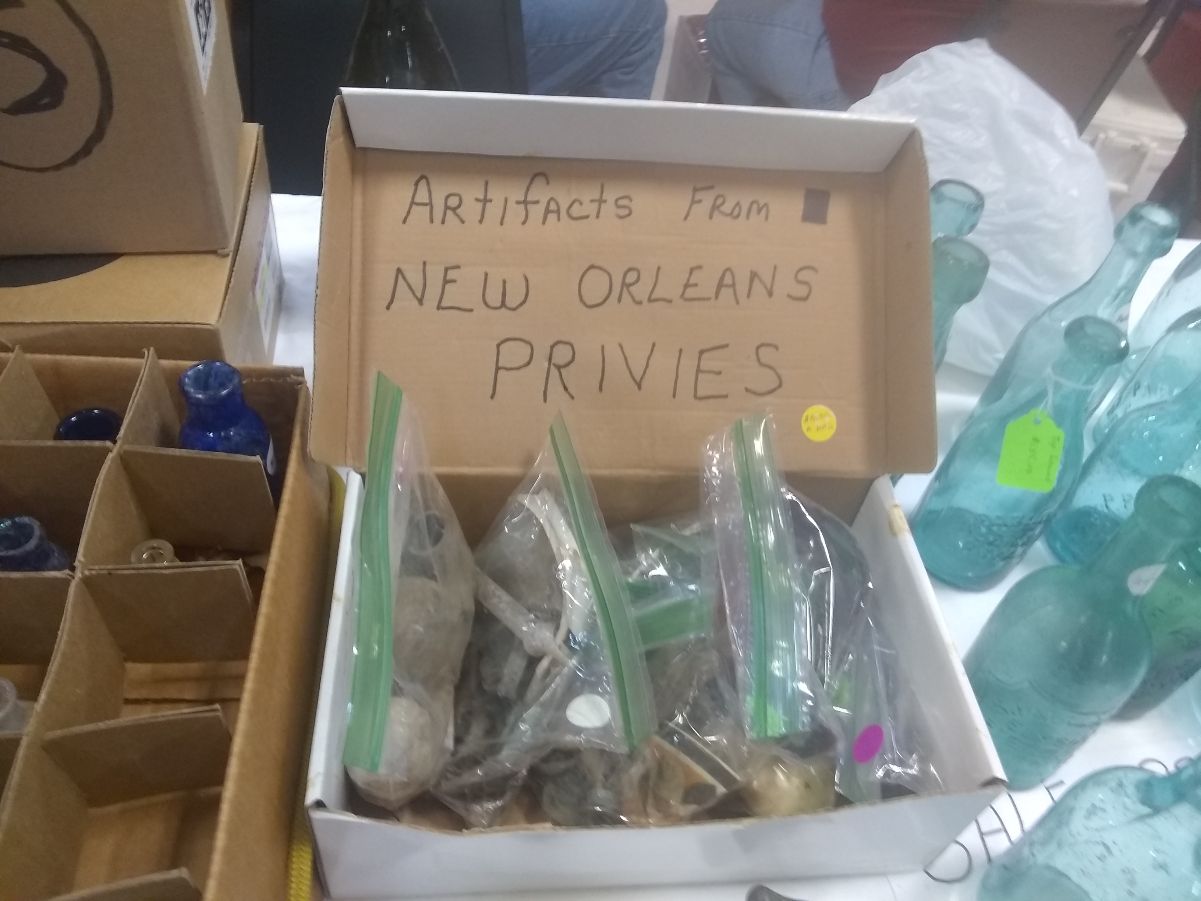
We have been around University archaeology and lab classes, sanctioned digs and lab identification long enough to know that this stuff really was dug. It shows distinct signs of having been found in stratigraphy which is one of the guiding lights of archaeology.
Stratigraphy is the study of layered deposits—called strata—that build up over time at a site. It’s one of the most important tools archaeologists use to understand the chronological sequence of human activity. In New Orleans there can be a remarkable number of strata in one single spot—remember, each layer represents a different time in the past.
Outhouse diggers don’t usually care about the layers of their dig, but it does mean that these little bags of artifacts often contain surface finds (before the ground is broken) as well as samples of artifacts from the deepest layer. We cannot tell the strata of these artifacts, of course, but we can certainly tell that some artifacts are much older, thus they were found much deeper, than others.
Most bags contain marbles, but they also hold so much more. We really enjoy the history and secrets buried in the ground. And at this show each bag cost $5.00!
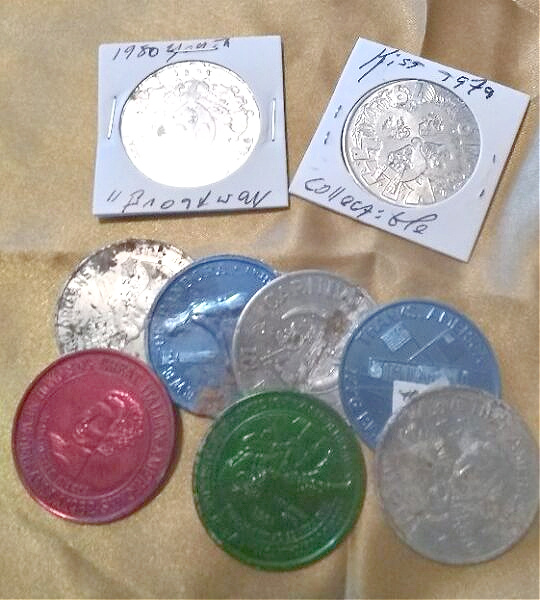
Inside The Bags: Mardi Gras Tosses
We collect tosses simply because we have lived in Mardi Gras[2] towns for a quarter century and we enjoy finding them. And sometimes we look up the history of the doubloons, usually but not always, made of aluminum.
There were a number of interesting throws in the two bags that we bought. Check at the top of this photograph. It is an unremarkable silver toss. It dates to 1979.
This little doubloon was tossed by the Krew of Endymion in Kenner, Louisiana, because of a police strike in New Orleans. Their theme that year was Token of Youth.The token is branded “Kiss” to honor the band’s role in Mardi Gras that year! Kiss? The one and only not only participated in the parade, but they played at the Endymion Ball! In May of 1979 Kiss released Dynasty in which drummer Peter Criss sang “Dirty Livin”. To say the least, this doubloon is very special to memorabilia collectors.
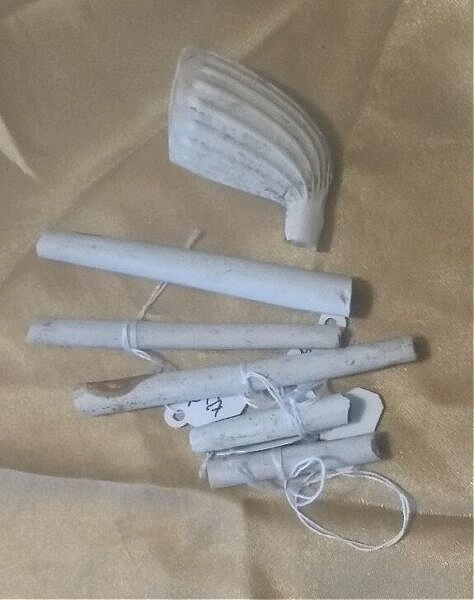
Pipes Bowls & Stems
We almost always find these old ball clay or kaolin clay bits and bobs of pipes at bottle shows since most bottle collectors are diggers and since these bowls and stems are so very prevalent[3]. We buy a few almost every chance we get for love of the history each piece holds.
Nothing terribly unusual in this lot. However, the stem with the larger diameter at the top of this photograph is branded, and it is unusual for us to find a maker’s mark on a stem or bowl.
It is marked “S 79 W.White and 500 W.” The pipe was made by William White pipe makers in Glasgow. Since it is not marked “Glasgow,” it is post 1891 when the United States government required imported goods to be marked with their country of origin.
The Bowl Is Much Older
We thought that the lot, to include the bowl, would all date to about the same time period: about 1870 – 1920 or so. But remember what we said earlier about stratigraphy? We learned after hours and hours of study and research on this bowl that while the digger often logically placed like artifacts together, the stem fragments and the bowl are in fact from different layers of soil and are far apart in time.
As far as we can remember, all the bowls that we have bought, in shops or bottle shows, have a heel, boot, or spur. We found a gorgeous glazed American pipe in Pensacola Bay once, and it, too, had a heel.
This one found in New Orleans is heel-less. These were common in both British and French colonial contexts. Pipes without a heel or spur are often categorized as “heel-less” and may date from the late 17th to early 19th century[4]. The bowl also has a 20° tilt. That slight an angle suggests a forward-leaning bowl, which was typical of certain mid-18th century styles. It could indicate a transitional form between earlier upright bowls and later forward-angled ones.
The deep molded lines are also unusual. These may be decorative mold seams or stylized botanical/geometric motifs. Such features were common on locally made pipes or lower-quality imports
Our bowl has not been smoked and we finally realized why. It has a tiny hole which is so offset to the bowl that we can’t imagine that it would even be possible to draw smoke from the bowl! Since the bowl hole is unusually small, and there’s no charring or residue inside, it is a misfire from the mold or a pipe that was never used—possibly discarded during manufacture or broken before use and tossed into the privy!
New Orleans had both strong French and Spanish colonial influences, so we believe that our pipe could be a French colonial pipe, possibly made locally or imported from France. We are also confident that the pipe is from the 18th to early 19th century, which makes it as much as 100 years older than the stems!
We are not pipe specialists. But we spent hours researching these little fragments. So, if any of our readers knows anything more, we welcome them to tell us all about it and we will gladly update this section.
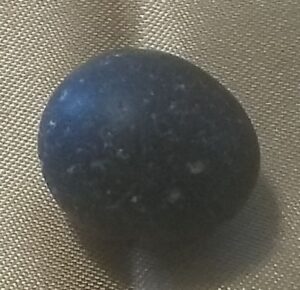
Marbles From The Ground: An Oddment
This little egg is covered in pocks. We thought at first that it is stone, but there are no other stones this color in the lot. We have some black stone marbles which are artifacts imported from Holland in the late 1700s-early 1800s, but we dismissed that idea, too.
In fact, it is kiln-fired clay! All those little dings allowed us to see the clay body which is light tan to white. We know from our study of ceramics that the black glaze found on antique clay marbles—especially those from the 19th century—was typically made using iron oxide as the primary colorant.
Common Ingredients in Black Glaze & The Firing Process
The most common pigment used to produce black or dark brown glazes is Iron oxide (Fe₂O₃) which is stable at high temperatures; it was widely available in the 19th century. Manganese dioxide (MnO₂) was sometimes added to deepen the black tone or create a more metallic sheen. Cobalt oxide was rarely used for black, but occasionally mixed in small amounts to adjust the hue. Our little egg seems to have had the full treatment!
These glazes were applied to the clay surface and then fired in a kiln. The final color depended on the glaze thickness (ours was thin), firing temperature, and the kiln atmosphere (oxidizing vs. reducing). We believe, but can never be certain, that our marble got out of round inside the kiln during firing. We can’t imagine that a craftsman or woman would place something so out-of-round in the kiln to fire!
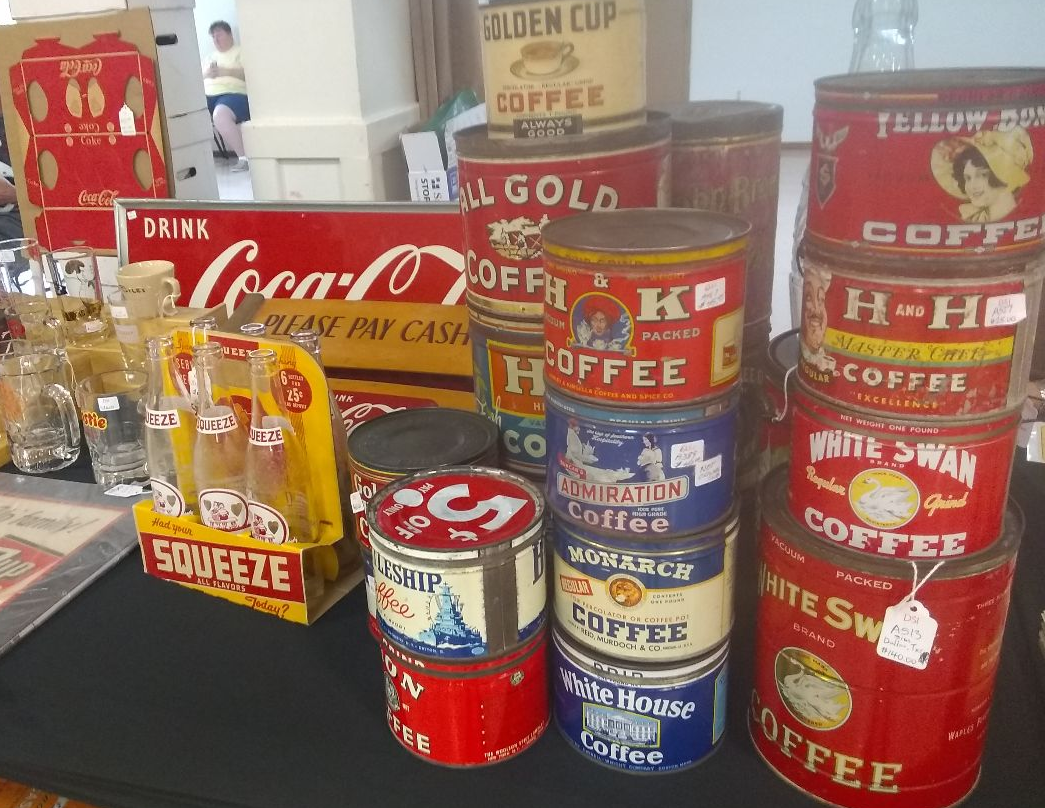
Our little wonky is most likely a white clay body with a thin iron-based glaze that’s worn from use or burial. It’s a beautiful example of early ceramic craftsmanship!
We wonder, but, again, will never know, if bags of black-glazed (in our case really just slipped) marbles were for sale in New Orleans shops? Did all the bags have wonkies? Or did these just show up from time-to-time? Frankly, the craftsmanship needed to make these black clay marbles seems to make them very special to us!
Hot Ending!
To say the least, we enjoyed this 8th Annual Biloxi show and sale tremendously.
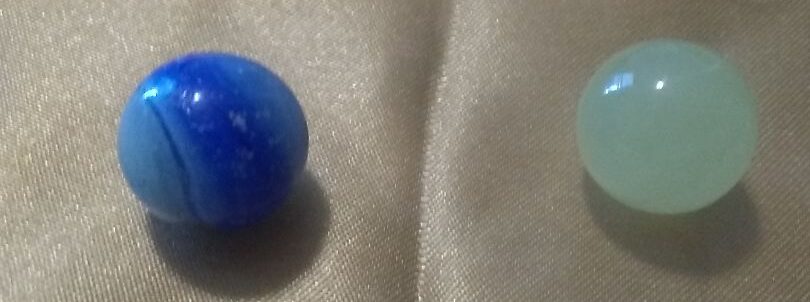
Here are two Akro Agate marbles pulled from the bags. The one on the left is a gorgeous ⅝” Popeye. It is a swirled (some call it a Corkscrew) translucent base with light blue-gray, and a deep blue swirl. Regrettably, it is badly dinged and would probably be graded only “collectible”. This one must have come from the top strata.
The marble on the right in the photograph is a ⅝” mint Akro Agate Aide of some sort. It has no swirls, but we believe that it is a Lemonaide. Again, it is either a surface find or a top strata.
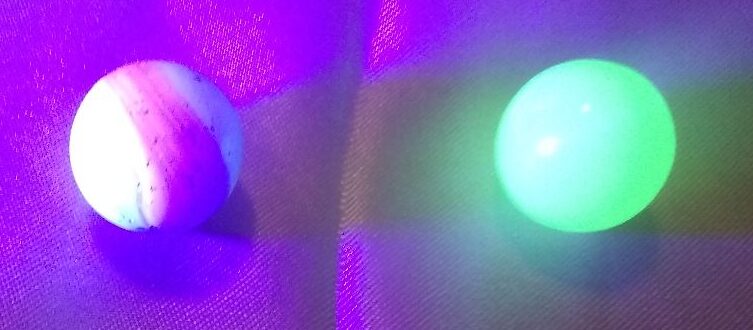
Now take a second look at the two marbles! Both are UV and the Aide is on fire!
The UV-reactive cullet used by Akro Agate in their early marble production likely came from discarded glass items—especially bottles and jars made with uranium-based Vaseline glass. Collectors and historians suggest that much of this cullet was sourced from publicly discarded glassware, which was then repurposed by marble manufacturers like Akro Agate[5].
This type of glass glows under UV light due to its uranium content, and it was commonly used in household items before the health risks of uranium were widely understood.
Akro Agate would have acquired this cullet either directly from glass manufacturers or indirectly through recycling and salvage operations. Some of the cullet has even been found dug up at the old Akro Agate factory site, confirming its use in production[6].
If you’re into marble collecting or glass history, the UV-reactive pieces from Akro are especially prized for their vibrant glow and historical significance.
Pooped But Happy!
As we said from the beginning, marble collectors can and do have lots of fun at bottle shows. At bottle digger and collector shows, we light up like kids in a candy store.
The air buzzes with stories of rare finds and lucky digs when sellers cluster in small groups. Many of the tables overflow with shimmering swirls of glass history. Diggers are more than happy to tell you about every tiny artifact on their tables. And you may be astounded, like we often are, about the prices! We have often been told “Oh just take it.” Remember, at this show those old bags of New Orleans history were $5.00 each!
And then they add the stories about where they got “them old marbles.” It has never been the price, from nothing to $2.00 to as much as $1,400 for a single marble, for us. We aren’t flipping marbles. We are learning, adding intrinsic value where we can from the lore told by the women and men who hand the artifacts over to a new owner.
Marble collectors swap tales, trade treasures, and sometimes stumble upon that elusive Akro or Christensen piece that makes the whole trip worth it. It’s not just about the marbles—it’s the thrill of the hunt, the camaraderie, and the joy of rediscovering forgotten gems buried in time.

- If you want to read more about these marbles then see https://apps.jefpat.maryland.gov/diagnostic/SmallFinds/Marbles/LargeImages/StonewareMarble/18BC80-119-2-stoneware.html 10/13/2025 ↑
- Mardi Gras in New Orleans dates back to at least 1710, when the Boeuf Gras Society was formed, though celebrations began even earlier with French holiday in 1699. That makes Mardi Gras in New Orleans over 300 years old, with its roots stretching back more than three centuries. The first official parade in New Orleans was organized in 1857 by the Mistick Krewe of Comus, introducing the elaborate floats and masked revelers that define the celebration today. ↑
- As one example, archaeological excavations in Colonial Williamsburg have uncovered over 11,000 fragments of clay tobacco pipes, including both pipe stems and bowls, in Colonial Williamsburg. These artifacts span several centuries and reflect the widespread use of tobacco in colonial Virginia. Many of these fragments were even repurposed—for example, they were used in a ca. 1740 walkway beside the George Reid House on Duke of Gloucester Street Colonial Williamsburg. The fragments vary in style and origin, with some imported from England and Holland, and others locally made. They are valuable for dating archaeological layers and understanding social habits of the time. If interesting in learning more check Colonial Williamsburg | The Revolution Is Here. – Colonial Williamsburg 10/14/2025 ↑
- https://cmap.ufarch.org/ & https://digital.library.cornell.edu/ 10/14/2025 ↑
- I have some questions about the UV reactive marbles… – General Marble & Glass Chat – Marble Connection marbleconnection.com (10/15/2025) Uranium content in glass typically ranged from trace amounts up to 2%, though some pieces reached as high as 25% uranium by weight Uranium glass – Wikipedia 10/15/2025 ↑
- https://www.ebay.com/itm/388785889843 10/15/2025 ↑

